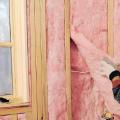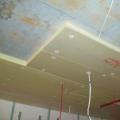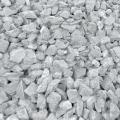How to waterproof under tiles?
Laying the coating in a bathroom or toilet must provide protection from moisture. At the same time, waterproofing the floor under the tiles is done in different ways, using both very inexpensive and effective rolled materials, and using mastics, as well as special one-component compositions. Each of the methods used differs both in the level of financial investment and in the general requirements for the qualifications of the performer.
Waterproofing for laying tiles in the bathroom is done very carefully. It is not only the relatively large amount of moisture that is often present on the floor that plays a role here. The task is to provide protection from steam and condensate.
This is important for a number of reasons:
- it is necessary to ensure that there are no leaks to the lower floor or basement;
- it is necessary to protect interfloor ceilings from the destructive effects of moisture;
- steam, penetrating concrete and other structural materials, has a negative effect, causing rotting, corrosion, destruction and a decrease in the overall temperature and strength characteristics of walls.

When carrying out waterproofing work under tiles, you need to pay attention to every little detail. To ensure the durability of the coating, it is necessary to level the floor and walls as carefully as possible. Then the loads on the tile will be distributed evenly, there will be no danger of splitting due to pressure, lag of individual elements, or cracks due to temperature deformations.
Leveling the floor surface is mandatory; in the case of a relatively smooth surface, cracks and depressions are sealed with putty. If there are strong unevennesses, it is recommended to remove the old one and make a new thin concrete screed reinforced with plastic mesh.
Application of roll materials
The tiles can be laid on a waterproofing base created using rolled materials. This type of insulator is only suitable for protecting the floor.
In this case, they distinguish:
- laid covering;
- weldable materials;
- waterproofing on a self-adhesive basis.
It is easiest to lay floor-type roll insulators on a prepared, flat, debris-free floor surface treated with anti-mold primers. This can be roofing material, one-way penetration membranes (which also have vapor protection), thick polymer films.
The nature of the work may vary depending on the material
- If polymer films, membranes, or non-woven material are used, the strips are placed along the length of the area to be covered, with an overlap of 5-10 cm. The joining lines are taped.

- Working with roofing felt and other materials containing bitumen or viscous polymer compositions can be done in two ways. The first is the use of mastics. The overlap area of the strips is thoroughly coated, and the seam is rolled with a roller. The second is temperature exposure. You can use a hair dryer or a special soldering iron. The taping method also shows acceptable results.

- The use of floating coatings involves intense temperature exposure. The main tool in this case is a gas burner. Since ventilation may be a problem in a limited bathroom space, you can use heat guns or high-power hair dryers. When fusing the coating onto the base, special attention is paid to the overlap zone. It needs to be thoroughly warmed, pressed, smoothed.

When working with floating materials, respiratory protection measures should be taken if open flames are used. It is also necessary to take into account all fire safety rules and not work with fire if the characteristics of the building do not allow such actions.
- A separate segment of waterproofing products are roll materials containing bitumen, which have a ready-made adhesive base. It is convenient to apply them; to do this, the protective film is gradually peeled off directly from the roll during deployment. All work can be carried out by one person.

The use of rolled waterproofing materials in preparation for laying tiles must be carried out by following a few simple rules:
- the perimeter is thoroughly coated with bitumen or mastics;
- the film or other type of coating is laid so that the material “fits” 10-15 cm onto the wall;
- To waterproof the perimeter, special adhesive tape can be used; brands that are heated with a hair dryer show excellent performance.

To work with rolled materials, you do not need any special tools (with the exception of gas burners, if you choose floating type waterproofing). You will need a knife, tape measure, chalk or a simple pencil, as well as a brush to remove debris and a smoothing roller.
Working with roll waterproofing materials is simple and requires low financial investment. Both classic roofing felt, roofing felt, and materials based on fiberglass and polyester can be used. A thin concrete screed with reinforcement is made on top of the formed protective layer.
Technology of working with coating materials
Excellent protection indicators are observed if coating waterproofing is used. This technology has several advantages:
- you can protect not only the floor, but also the walls and ceiling;
- there is no need to carefully level the floor surface;
- after hardening, the liquid composition forms a perfectly smooth surface, perfect for laying tiles;
- modern compositions can also work as a floor leveling agent.
Coating waterproofing can be carried out with bitumen mastics or special polymer compounds. You don’t need a complex, unusual tool for the job. You will have to work with a spatula, brushes, or a rubbing roller.

If the floor surface is large, spraying installations can be used, but such work requires the use of expensive equipment and acrylic water-based compositions, which are expensive.
You need to work with coating compounds carefully, without missing a single spot on the surface. In the case of liquid polymer-based compositions, they are poured and distributed over the floor surface. At the same time, waterproofing with bitumen mastics does not eliminate the need to make a concrete screed, on the surface of which the tiles will then be laid.
Additional information: Optimal in terms of price, quality of coating, ease of work - a composition based on cement and polymer mastic looks like. It is fluid enough to be easy to smooth out. Forms a perfectly smooth surface. It has an attractive price for the consumer. The level of strength is such that there is no need to lay a screed - with the help of a cement-polymer composition, you can bring the floor height to the desired level.
Application of one-component mastics
Waterproofing material such as one-component mastics belongs to the latest generation of products for treating floors and walls for laying tiles. They have the property of adhesion of layers, so they do not form seams, ensuring the creation of a monolithic and durable coating. Coating waterproofing using one-component mastics has a number of advantages:
- there are no seams, neither horizontally within one layer, nor vertically, within the thickness of the entire coating;
- there are no weak spots in the coating, it is as tight as possible;
- applying the composition is not difficult; you can work with a brush and roller;
- By making waterproofing with one-component mastics, it is easy to guarantee protection against mold, fungal growth, and microorganisms.
It is always worth remembering one basic property of one-component formulations. After drying, the waterproofing does not protect against steam penetration. In some cases this is useful - the room “breathes”. But in most cases, this property of the mastic acts as a disadvantage, so a one-component composition is often used in combination with simple film means of moisture protection.

Waterproofing with one-component mastic is done in compliance with a number of rules:
- Each applied layer must dry. The time depends on the specific indicators of humidity and temperature, so before applying a new portion of the composition, check the stickiness of the drying material - the composition should not remain on the fingers.
- If it is necessary to create a thick layer and thus raise the overall floor level, the best results are achieved by using fine quartz sand. Each layer of mastic is sprinkled before final drying in order to achieve maximum adhesion to the next one.
- Sand should be removed from the top layer of mastic. A fine brush is suitable for this.
After the waterproofing with one-component mastic is ready, it is necessary to allow time for final polymerization. The fact that the top layer does not stick to your fingers is not a sufficient indicator. Before proceeding with the installation of the tile covering, you need to wait from 1 to three days. It is best to find out the amount of time from the recommendations given by the manufacturer of one-component mastic.
As a conclusion
Waterproofing the floor for laying tiles has a clearly defined procedure for carrying out the work. If the stage of laying the protective surface depends on the specific material chosen, then the general course of preparatory operations is mandatory.
The surface is leveled and cleaned of dust using shields and a vacuum cleaner. If there are cracks or areas of deteriorating coating, they are removed. Putties are used to fill cavities.
If there are large differences in height and holes on the floor, you should remove the old one and make a new thin reinforced concrete screed. By carrying out all the work carefully and carefully, you can guarantee that both the waterproofing and the tiled flooring will work effectively and last for a very long time without causing trouble.
 Construction materials and list of works
Construction materials and list of works Proper insulation of a wooden ceiling in a private house
Proper insulation of a wooden ceiling in a private house What types of crushed stone are there?
What types of crushed stone are there?